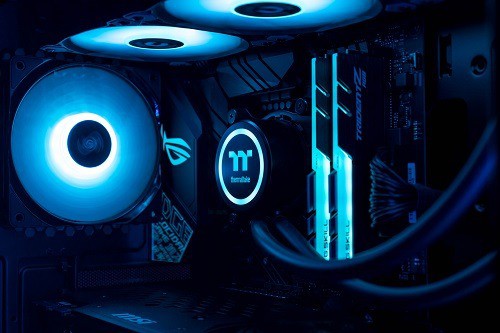If you are a gamer, you probably know the importance of cooling fans in a gaming PC. A gaming PC can be cooled in two ways; liquid cooling and using case fans.
Liquid cooling is not available to most gamers as it is expensive when compared to case fans. So, our today’s article will focus on case fans.
The need for fans in gaming pc is self-evident. All that hot air created by your equipment, particularly video cards and CPUs, must be removed and replaced by “fresh” and cooler air.
Catching all that heat in a bound space with next to zero departure doesn’t resist anything, and the truth is told, it can possibly harm parts. Most present-day motherboards, CPUs, and video cards contain temperature thermometers that auto-closure on the off chance that it gets excessively hot.
So, please don’t go anywhere because today we will talk about everything you need to know regarding cooling fans for CPU, like how many fans a gaming pc need and many more.
How many fans does a gaming PC need?
You should get a minimum of 3 fans for your gaming PC, not including the power supply, CPU, and GPU fans. Your cases should have slots for fans in which you can install your fans by yourself in case it doesn’t come pre-built with fans. However, I will suggest you not spend too much on cooling systems.
Everything has the potential to undo your hard work, and components should be optimized to avoid doing so. This is mostly applicable to cooling and electricity, but it could be applied to almost any variable. You can install cooling fans yourself in virtually any case. For this, you just need to do a bit of DIY.
To generate high pressure, you need more intakes versus exhausts. This ensures that the intakes pull in more oxygen than the exhausts expel. However, excess air will spill out of some vents and minor cracks/crevices in your case to re-equalize the pressure with the outside. As a result, the intake fans are the only way air enters the situation.
The interior of your case will then be cleaned regularly by air purifiers above your intake fans. In case you have more exhaust fans, that implies air will instead be sucked in through each one of those little vents and left to adjust pressure. The residue will unavoidably get sucked in alongside the air, and you can’t channel each small opening around your case, so your inner parts will get dusty over the long run.
While talking about standard mid-towers, the general rule is to go for two intakes and one exhaust fan. But that is simply to keep up certain pressing factors and keep however much residue as could reasonably be expected on the front filter. However, in most adequately ventilated cases, you can get along quickly with just one intake or exhaust fan. You shouldn’t need to force more air to keep the system happy unless you’re using SLI, vigorously overclocking everything, or have large ambient temperatures.
Are 2 fans enough for a gaming PC?
The best upgrades to CPU and GPU thermals come from two case fans; 1 intake in the front, and 1 exhaust in the back. It varies on the hardware and case configuration, but a single intake fan is sufficient for most general-purpose computers. 1/1 is sufficient for a low-end gaming PC, while 2/1 or 3/1 is needed for higher-power hardware. Excessive top or bottom fan combinations are useless whether you’re using incredibly high-power pull pieces or just for fun.
Where should I place the fans if I use 2 fans for a gaming PC?
Well, it is important to think about the position of the fan for gaming pc. A suitable position would be one at the base front to acquire air and possibly one close to the top back to eliminate it. Try not to allow fans to battle each other, for instance, allowing two fans to sucking or blowing towards each other or a fan short-circuiting the flow of incoming air and pushing it out of the case until it can cool the remainder of the case.
There have been many incidents where the gaming pc wasn’t able to cool itself despite it having 10 fans, and the main reason was the wrong position of the fans. All the fans were attempting to get air in, but insufficient fans attempted to deplete the air out.
Are 1000 RPM fans powerful enough?
Everything but the hottest systems will most likely be cool enough with several 1000rpm fans. Though the low-speed fans can still be too noisy at 12v, you might need to get the fan controller instead.
The majority of CPU fans spin at 5000 RPM. If you want your machine to be cool all at once, 1000 to 1200 RPM is a little low in that situation. The standard RPM for your CPU fan should be about 3000 to 4000 RPM to effectively cool down your PC. This is it. The size of the fan, on the other hand, is a factor. The RPM level for small and large CPU fans can differ. Small fans, for example, could spin at 3000 to 4000 RPM and move the very same flow of air as a large fan spinning at 1000 to 2000 RPM.
If you’re going to use more than a couple of fans, it’s best to go with the low-RPM fans. If you use more than three case fans, you can learn how to use a 5v or 7v fan mod or purchase a fan controller.
Can I set all the fans at max speed in my gaming pc?
Yes, you can run the fans at max speed in your gaming pc; It’s not bad for them; they’re designed to spin that quickly. However, their lifespans might be shortened. After that, a fan spinning at maximum speed would spin faster, but each fan could only spin so many times before the bearings wear out.
In our years of experimenting with gaming pc and fans, we have seen fans on “low” bite the dust early and have been fans at “max” turn for quite a long time and years. As long as heat isn’t a problem, we would suggest you set the fans at the lowest setting possible, just enough to take out the residue and dust.
Are more fans better in a gaming PC?
If you are an experienced gamer, you already know that more fans technically doesn’t mean you will have more cooling. Negative pressure produces stronger thermals than positive pressure. Positive pressure stops pockets of hot air from forming, while negative pressure causes them to form.
However, many people are avoiding using negative pressure as debris can enter the case through all of the tiny little gaps. Negative pressure will put so much dust into your CPU that it can get serious and cause problems.
If you operate purely positive pressure, especially with only intakes at the top, you risk choking the case and trapping heat inside. While both are adjustments, slightly positive is better with dirt buildup while holding thermals fine, and negative is best for thermals but worse for dust.
So, to have the best results, you won’t need more fans. What you need to do is create a balance between the number of fans for intake and exhaust.
Is it okay to run GPU fans at 100%?
Technically yes, you can run the GPU fans at 100%. But, there will make huge noise which will not be very pleasing to the ears. However, if you can bear this sound, that means you will have more power.
There is another problem with running the GPU fans at 100%. You’ll put more strain on the fans, but they won’t break down too soon. When the bearings die, you will hear them go moreover, as they are already rated at 12 volts. At rest, the core clocks off, so there’s no need to run the fan at full speed.
What is the meaning of RPM of case fans?
Fan blades with a shorter diameter and a higher pitch are used in higher-speed, higher-CPU fans. RPM has nothing to do with actual efficiency; it’s simply a measure of the range of performance; a well-designed fan at 1000rpm can deliver an equal performance as a poorly designed fan at 2000rpm.
Fans usually produce sufficient noise to be detectable around 900ish rpm, and the faster the rpm, the louder it becomes. So, the ideal rpm of your fan will depend on your setup as well as the number of fans and the type of fans you have.
What is the ideal CPU Fan speed while gameplay?
It largely depends on the kind of computer cooling system you have. If you have a stock CPU fan, the recommended CPU fan speed range is 70 percent RPM or higher. Adjusting RPM to 100 percent is the ideal CPU fan speed for gamers whose CPU temperature rises 70 degrees Celsius. The standard CPU fan speed at 50°C to 55°C should be about 50% of the total RPM.
Should graphics card fans always spin?
It depends on the type of graphics card you are using. The fans on the latest graphics cards do not spin till a specific temperature is reached. Unless the fan curve is changed, they will not turn on until the specified time. You can set a faster speed and keep them on all of the time. However, GPU fans are very noisy, and if they are on all the time, you can most likely hear them.
Generally speaking, in most new graphics cards, the fan starts to spin only when the GPU temperatures rise to 50-55 C. The GPU will cool down around 30 C, and the fan will turn off automatically.
Conclusion
When you go and build your own gaming pc, you might ignore smaller things like the number of case fans. But all experienced gamers know how vital a fan is for gaming pc. Now the main question comes how many fans does a gaming pc need?
Today we wrote everything related to this question to help you understand everything you need to know related to fans for gaming pc. So what are you waiting for? Build your gaming pc and start to play? Happy Gaming!!

Hello Good People! This is Pavel and Welcome to PC Delight!
I’m an Electronics Engineer by profession with a passion for Gaming & PC builds. When I came up with the idea for PC Delight, it was my goal to share & offer the very best PC building ideas to tech-loving people like myself.
Since my school days, I’ve been just addicted to gaming & PCs. That leads me to experiment with various ways around the very niche, resulting in great productivity. And I’m here to share those practical experiences. So that next time you start some experiment with your PC builds or struggle to cope with a certain game, I’m here with the solutions. With these philosophies, I started my journey in 2017 and just kept going.
